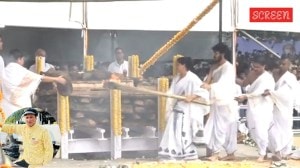Letters to the editor
Bibek Debroy’s article, ‘Thus it was or wasn’t’ (IE, September 18), was a pleasure to read.

More to myth
• Bibek Debroy’s article, ‘Thus it was or wasn’t’ (IE, September 18), was a pleasure to read. The history of science has shown that the more we know, the more we realise the extent of what we don’t know. Scientists once assumed that they had understood matter, today after digging deeper we don’t know for certain what the basic building blocks of nature are. A deepening knowledge of science brings with it great humility, not arrogance. Newton and Einstein (who turned Newtonian physics on its head) experienced this humility when they realised the vastness of the unknown. Compare this with the cockiness of a few mediocre archaeologists who make sweeping statements about figures and events that can’t be disproved just as they can’t be proved.
There is a thin line separating history from mythology and experience has shown that semi-historical or mythological figures have a basis in history. King Arthur is a case in point. Long believed to be a mythical figure, archaeological and historical findings in the last decade have pushed him towards the realm of history rather than mythology. The existence of King Arthur can never be disproved just as the existence of Lord Ram can never be disproved. In fact, the elaborateness of the Ramayana makes it very likely that there is a basis in history for the core story. But the issue is much more than this. Ram is not King Arthur, Ram is sacred to millions. His existence is not dependent on facile television debates. Millions see Ram Sethu as the bridge of their Lord. It must be preserved at all costs.
— Rahul Naik Ahmedabad
Defeated purpose
• THE heading of the article, ‘Universities are for a higher purpose’ (IE, September 20) is in itself a statement which anyone would unhesitatingly accept for universities in the advanced countries. In countries like ours, however, they are also developing into ‘parking lots’ for spoilt brats and their cronies. Have we ever heard of students in Germany or Switzerland or France behaving in the way we have recently seen them act in Aligarh? This city, unfortunately, is not even an isolated case.
— Satish Dayal New Delhi
Model protesters
• MOST of the hapless consumers – the homemakers who have to balance their limited budgets – will be hit by the ongoing protest against organised retailers like Reliance Fresh by what are obviously vested interests of powerful middlemen. What is most objectionable is the violent nature of these so-called protests. Burning public property or damaging retail outlets won’t hurt the Ambanis, they will only hurt the public. In India today, middlemen are exploiting farmers and consumers alike. In the West, too, people have protested at the entry of outlets like Wal-Mart and Bloomingdale, but the protests are civilised and by way of picketing in front of such outlets to dissuade consumers.
— Kishore Karnad Sunnyvale, CA
Life of label
• IT was interesting to read Viveka Chauhan’s ‘North-South jaw-jaw’ (IE, September 13). The confusion about southerners has a colonial background. The Madras Presidency, during the Raj, covered almost the whole of south India. So for northerners every south Indian was a ‘Madrasi’. After the creation of linguistic states, things changed, but labels, and misperceptions from them,persist.
— R.K. Bhanti Bhavnagar
Photos



- 01
- 02
- 03
- 04
- 05




























